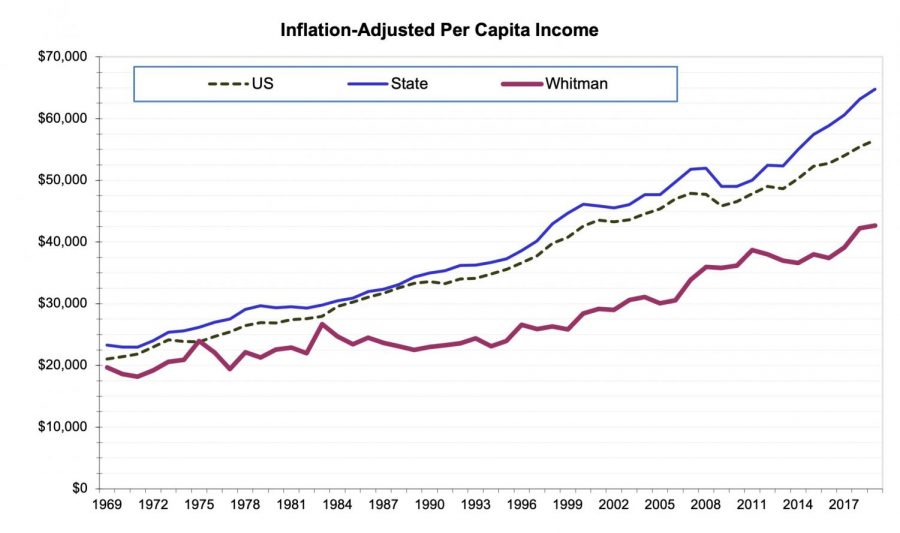Wheat harvest, WSU enrollment are ‘cornerstones’ of county economy
WSU tied to 53 percent of jobs; wheat price dependent on weather conditions, global trade
COURTESY OF WASHINGTON STATE EMPLOYMENT SECURITY DEPARTMENT
Per capita income in Whitman County sat at $42,665 in 2019, which is an increase from $42,215 in 2018.
September 22, 2021
Enrollment at WSU and productive agricultural harvests are important to a successful economy in Whitman County, but both can be difficult to predict.
One issue with tracking economics is that certain information is often delayed, said Doug Tweedy, regional economist for the Washington State Employment Security Department.
A lot of information is based on taxes, so it can take up to a year after tax season ends to receive updates on things like average income and wages, he said.
The median hourly wage in Whitman County in 2018 was $22.51 after adjusting for inflation, according to an ESD spreadsheet. This is an increase from $22.08 in 2017.
Per capita income in Whitman County sat at $42,665 in 2019 after adjusting for inflation. This is an increase from $42,215 in 2018. The county is ranked 32 out of 39 counties in Washington State for per capita income.
In Whitman County, 26.5 percent of residents lived below the poverty line between 2015 and 2019, according to the spreadsheet. This is because of the large portion of college students living in Whitman County, according to the ESD.
The unemployment rate for the first nine months of 2020 sat around 4.5 percent, according to the ESD.
WSU and the agricultural sector are the cornerstones of Whitman County’s economy, Tweedy said.
“Everything is being driven by those two foundations,” he said.
WSU
WSU is directly tied to 53 percent of jobs in the county. Academics and athletic programs offered by the university draw in students and visitors, who contribute to the economy when they stay here, Tweedy said.
An enrollment decrease or canceled sports season can have a major impact, he said. That means fewer people staying in hotels, going out to restaurants, buying tickets to games and generally fewer people purchasing goods and services in Pullman and Whitman County.
The fall semester saw a 3.9 percent decline in enrollment at WSU Pullman, said Phil Weiler, WSU vice president of marketing and communications. The campus retention rate saw an increase of 2 percent.
This retention rate is incredibly important because schools across the nation including WSU were unsure how the transition to online learning during the pandemic may change things long term, he said.
Last fall saw a 5.1 percent decrease in enrollment at WSU Pullman, according to the Office of Institutional Research.
It is also very difficult to predict future enrollment at WSU, Weiler said.
“It’s a finger in the wind, as opposed to anything based in science,” he said.
It will likely take several years to recover completely from the effects of the pandemic. Enrollment numbers were at record highs in the years leading up to the pandemic, he said.
Agriculture
There are many different influences involved in agriculture and its relationship with the economy, Tweedy said.
The price of wheat is affected by the global value of the dollar, the quality of the wheat and the success of other countries’ wheat harvests, he said. If there is a successful harvest in other countries or there is a large global supply of wheat, the price of Washington’s wheat may be driven down.
This year’s wheat harvest has been less successful than recent years due to a particularly hot and dry summer, said Sam White, chief operating officer for Pacific Northwest Farmers Cooperative.
The quality and quantity of wheat in Washington has decreased. The lack of rain in the spring and summer reduced the quantity of wheat by at least half, as well as other products from the Palouse, he said.
White wheat contained a high amount of protein because of the weather conditions. Buyers were given steep discounts because the levels were higher than they normally like, White said.
This year’s smaller yield also means less money for farmers and the people who work for them. In a regular year, farmers have more money to spend in places like parts and machinery stores for their equipment, he said.
“They just don’t have the dollars to spend this year,” White said.
Rain throughout the coming seasons will help with next year’s harvest, he said.
“We hope that we can go back to something more normal for next year and get back to the good crops that we can raise on the Palouse,” White said.










